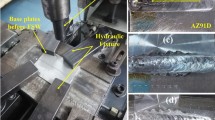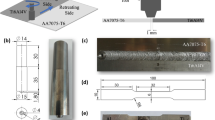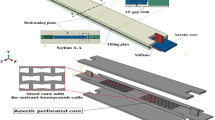Abstract
Four-point contact ball bearings (X-ACBBs) are highly effective in applications requiring support for shafts that feature a high ratio of diameter to unsupported axial length and axial loading in two directions. In an effort to predict and understand problems that have been reported in X-ACCB usage, new modeling and analysis of the contact load and stiffness of X-ACBBs has been presented. The new model features a quasi-static model for X-ACBBs subjected to five degrees-of-freedom loading and displacement. The model was validated against numerical ball contact loads available in the literature. A numerical investigation was then performed to study the effects on ball contact loads and stiffness of rotational speed, external loads, and various geometric parameters of bearings such as arching dimension and unloaded contact angle. Under pure axial load, increasing the rotational speed causes an abrupt change in X-ACBB stiffness when the ball contact changes from two-point to three-point contact. Gyroscopic moment reduces the speed at which transition from two-point to three-point contact occurs. The dependence of X-ACBB stiffness on arching dimension and unloaded contact angle reveals that those parameters are critical for the design of X-ACBBs.


















Similar content being viewed by others
Abbreviations
- \(a{ }\) :
-
Semi-major radius of contact ellipse, mm
- \(c\) :
-
Load–deflection constant
- \(D_{a}\) :
-
Ball diameter, mm
- \(d_{m}\) :
-
Pitch diameter, mm
- \(\left\{ F \right\}\) :
-
Load vector
- \(F\) :
-
External load, N
- \(F_{c}\) :
-
Centrifugal force, N
- \({\text{g}}\) :
-
Arching dimension (shim size), mm
- \(J\) :
-
Ball mass moment of inertia, Nmm2
- \(\left[ k \right]\) :
-
Stiffness matrix
- \(M\) :
-
External moment, Nmm
- \(M_{g}\) :
-
Gyroscopic moment, Nmm
- \(m\) :
-
Ball mass, kg
- \(n\) :
-
Rotational speed, rpm
- \(\left[ {Q^{\prime}} \right]\) :
-
Ball Jacobian matrix
- \(\left\{ Q \right\}\) :
-
Inner ring contact load vector
- \(Q\) :
-
Contact load, N
- \(\left[ {R\phi } \right]\) :
-
Transformation matrix
- \(r\) :
-
Raceway curvature radius, mm
- \(T\) :
-
Contact moment, Nmm
- \(\left\{ u \right\}\) :
-
Inner ring contact displacement vector
- \(u\) :
-
Inner ring displacement
- \(v\) :
-
Ball center displacement
- \(Z\) :
-
Number of balls
- \(\alpha\) :
-
Contact angle, rad
- \(\alpha_{0}\) :
-
Unloaded contact angle, rad
- \(\alpha_{s}\) :
-
Resting (shim) contact angle, rad
- \(\beta\) :
-
Pitch angle, rad
- \(\left\{ \delta \right\}\) :
-
Displacement vector
- \(\theta\) :
-
Inner race cross-section rotation, rad
- \(\gamma\) :
-
Dimensionless parameter, \(\gamma = D_{a} /d_{m}\)
- \(\omega\) :
-
Rotational speed, rad/s
- \(\omega_{m}\) :
-
Ball orbital speed, rad/s
- \(\omega_{r}\) :
-
Ball pivotal speed, rad/s
- \(e\) :
-
Outer raceway
- \(i\) :
-
Inner raceway
- \(j\) :
-
Rolling element index
- \(l\) :
-
Left ring
- \(r\) :
-
Right ring
- \(x,y,z\) :
-
Coordinate axes
References
Leblanc, A., & Nelias, D. (2007). Ball motion and sliding friction in a four-contact-point ball bearing. ASME, Journal of Tribology, 129(4), 801–808.
SKF. Four-point contact ball bearings—Two in one. Retrieved November 12, 2021, from https://evolution.skf.com/en/four-point-contact-ball-bearings-two-in-one/
Li, T., Kolar, P., Li, X. Y., & Wu, J. (2020). Research development of preload technology on angular contact ball bearing of high speed spindle: A review. International Journal of Precision Engineering and Manufacturing, 21, 1163–1185.
Tong, V. C., & Hong, S. W. (2018). Improved formulation for running torque in angular contact ball bearings. International Journal of Precision Engineering and Manufacturing, 19, 47–56.
Chen, L., **a, X., Zheng, H., & Qiu, M. (2016). Friction torque behavior as a function of actual contact angle in four-point-contact ball bearing. Applied Mathematics and Nonlinear Sciences, 1(1), 53–64.
Hamrock, B. J., & Anderson, W. J. (1972). Arched-outer-race ball-bearing analysis considering centrifugal forces. NASA Report No. TN D-6765.
Hamrock, B. J. (1974). Ball motion and sliding friction in an arched outer race ball bearing. NASA Report No. TM X-71442.
Amasorrain, J. I., Sagartzazu, X., & Damian, J. (2003). Load distribution in a four contact-point slewing bearings. Mechanism and Machine Theory, 38, 479–496.
Halpin, J. D., & Tran, A. N. (2016). An analytical model of four-point contact rolling element bearings. ASME, Journal of Tribology, 138(3), 031404.
Jones, A. B. (1960). A general theory for elastically constrained ball and radial roller bearings under arbitrary load and speed conditions. Journal of Basic Engineering, 82(2), 309–320.
You, H. Y., Zhu, C. X., & Li, Q. X. (2012). Contact analysis on large negative clearance four-point contact ball bearing. Procedia Engineering, 37, 174–178.
Lacroix, S., Nelias, D., & Leblanc, A. (2013). Four-point contact ball bearing model with deformable rings. ASME, Journal of Tribology, 135(3), 031402.
Chen, G., Jia, P., & He, J. (2013). Effects of geometric parameters on static load capacity of a double-row four-point contact ball bearing. Journal of Mechanical Science and Technology, 27, 1053–1061.
Chen, G., Wen, G., **ao, Z., & San, H. (2017). Experimental study on contact force in a slewing bearing. ASME Journal of Tribology. https://doi.org/10.1115/1.4037356
Wang, Y. S., & Yuan, Q. Q. (2013). Contact force distribution and static load-carrying capacity of large size double row four-point contact ball bearing. Defense Technology, 9, 229–236.
Joshi, A., Kachhia, H., Sridhar, M., & Nelias, D. (2015). Running torque of slow speed two-point and four-point contact bearings. Lubricants, 3, 181–196.
Liu, R., Wang, H., Pang, B. T., Gao, X. H., & Zong, H. Y. (2018). Load distribution calculation for a four-point-contact slewing bearing and its experimental verification. Experimental Techniques, 42, 243–252.
Tong, V. C., Hwang, J., Shim, J., Oh, J. S., & Hong, S. W. (2020). Multi-objective optimization of machine tool spindle-bearing system. International Journal of Precision Engineering and Manufacturing, 21, 1885–1902.
de Mul, J., Vree, J., & Maas, D. (1989). Equilibrium and associated load distribution in ball and roller bearings loaded in five degrees of freedom while neglecting friction-Part I: General theory and application to ball bearings. ASME Journal of Tribology, 111(1), 142–148.
Harris, T. A. (2007). Rolling bearing analysis. Wiley.
Bai, C., & Xu, Q. (2006). Dynamic model of ball bearings with internal clearance and waviness. Journal of Sound and Vibration, 294, 23–48.
Acknowledgements
This research was financially supported by the National Research Foundation of Korea (Grant No.: NRF-2019R1F1A1063783, NRF-2020K2A9A1A06107195).
Author information
Authors and Affiliations
Corresponding author
Additional information
Publisher's Note
Springer Nature remains neutral with regard to jurisdictional claims in published maps and institutional affiliations.
Appendix: Proper Arching Dimension
Appendix: Proper Arching Dimension
The proper arching dimension can be chosen depending on the geometry of X-ACBB. In this way, a design constraint is used to avoid overlap** the left and right outer race contacts. This implies that the arching dimension should satisfy the inequality as follows [7]:
Here, \({\varvec{a}}_{{{\varvec{e}},{\varvec{m}}}} ,\user2{ m} = {\varvec{l}},{\varvec{r}}\) correspond to the semi-major radii of contact ellipses in ball-race contacts. The arching dimension should also satisfy that the resting angle (\({\varvec{\alpha}}_{{\varvec{s}}}\)) is greater than zero and always less than or equal to the unloaded contact angle (\({\varvec{\alpha}}_{0}\)).
Rights and permissions
About this article
Cite this article
Rivera, G., Tong, VC. & Hong, SW. Contact Load and Stiffness of Four-Point Contact Ball Bearings Under Loading. Int. J. Precis. Eng. Manuf. 23, 677–687 (2022). https://doi.org/10.1007/s12541-022-00643-0
Received:
Revised:
Accepted:
Published:
Issue Date:
DOI: https://doi.org/10.1007/s12541-022-00643-0




